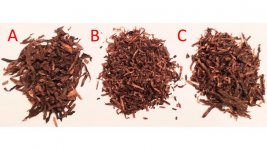For the sake of comparison here is a photo with (A) the original Blairgowrie, (B) the new Blairgowrie, and (C) Smokingpipes 20th Anniversary XX Flake Dark.

And below is my review of the old and new Blairgowries on Tobaccoreviews:
Reviewed By Date Rating Strength Flavoring Taste Room Note
incendio (42) 2017-10-21
★★★☆
Mild None Detected Very Mild Pleasant
Solid Virginia base in the nose, the Orientals and a slight Latakia note are present. The aroma is enticing and well-balanced.
The moisture is perfect for smoking right out of the tin, and is on the dry side--perhaps to the extent that there is not enough moisture in the can to sustain a prominent, fruity fermentation.
Tangy on the tongue, and sweet peppercorns from the Perique.
The real star is the marriage of Virginia and Orientals, supported more by the Perique than by the Latakia, which builds sparingly as you work your way down the bowl.
That having been said, this blend relies more on the marriage of tobaccos than on the quality of its Virginia base, which is slightly green and significantly less complex than the one featured in its cousin, McClelland's Matured Cake. I would argue that it's just good enough to be average and not bad. It may be true that when one bakes a cake, "any old egg will do" but for a blend sustained by a Virginia base, I do believe that the "building is only as good as its bricks," and that the mediocre quality of the Virginia hinders what would otherwise have been a stellar combination.
Definitely an all-day smoke. You won't tire of its honest qualities, and it's not of such a "special" character that you would feel some compunction about carelessly burning through several bowls. I am a great fan of this style of tobacco, and for a little more depth in the Virginia department I would recommend its cousin, Matured Cake, which is available in bulk.
[Revisitation: April 2020]
I had a little Blairgowrie remaining in a jar, left over from my earlier review, which I finished not too long ago. This is fortunate as I can say with some certainty that the changes I perceive aren't likely imaginary.
The earlier Blairgowrie was, to my mind, a smooth Virginia-Oriental with a smattering of condimental tobaccos to add intrigue and slight depth. There was a definite interplay between the Virginias and the buttery Orientals.
This current version was a rather abrupt change, more notable because the changes were in those particular aspects on which I was most keen. I popped open the tin and saw tawny broken flakes, which have since aired somewhat and mellowed to a chestnut brown. The earlier Blairgowrie was a paler sandy brown with a somewhat broader cut. I searched the record in these reviews to be sure I hadn't made some type of mistake.
What I discovered is that the Virginia component is the slightest bit more complex. Only very slightly: a bit of grass and hay was supplanted by a roasted malt aroma that lingered slightly on the tongue. To my dismay the earlier Oriental prominence had subsided considerably. My evaluation of the current composition of Blairgowrie is that it is now a Virginia (rather than a Virginia-Oriental) with condimental amounts of Orientals, Latakia and Perique.
What this blend has to offer it will unveil only when unhurriedly sipping the smouldering broken flake. Walking about or smoking in a breeze availed me nothing, and anything but the most leisurely cadence provoked a heat (not a bite per se) that toppled the subtle complexities.
Unlike the earlier edition, this current blend reminded me somewhat of the old Robert McConnell Virginias, except that the depth of body lies somewhat short of the current German (K&K) Hal o' The Wynd.
I'll continue working on this sizable tin and see what allure and charm may unfold as the blend breathes and further comes into its own.
[Edit 4/27/2020] If it's any help, the Virginia-Oriental used to resemble "Bijou" and now it's a darker Virignia, similar (probably identical, actually) to the Smokingpipes Dark Flake (but with a little smoky Latakia added). This sums up the change rather well I believe.
Pipe Used: several billiards and a stack
Age When Smoked: "fresh"
Purchased From: Smokingpipes
Similar Blends: [Older] Imagine McClelland's #2020 Matured Cake with a greener, more hay-like, less-matured Virginia., [Newer] A drier Hal O' The Wynd with a whisper of Latakia.
8 people found this review helpful.











